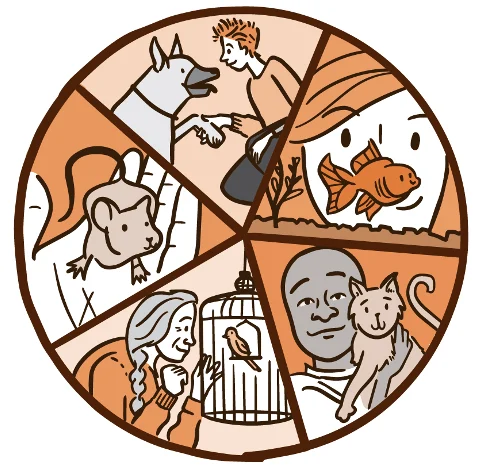Are Cats Apex Predators?
Cats have long been known for their hunting prowess and ability to dominate their environment. But are they truly apex predators? In this article, we will explore the evidence supporting the claim that cats are apex predators, as well as some interesting trends related to this topic.
Trend 1: Cats’ hunting abilities
Cats are known for their exceptional hunting skills, which have been honed over thousands of years of evolution. They have sharp claws and teeth, keen senses, and incredible agility, all of which make them highly effective predators. As one wildlife biologist puts it, “Cats are natural-born hunters, with the ability to stalk and capture prey with precision and speed.”
Trend 2: Cats’ impact on ecosystems
As apex predators, cats play a crucial role in maintaining the balance of ecosystems. They help control populations of small mammals, birds, and insects, which in turn helps prevent overgrazing and habitat destruction. According to a conservationist, “Cats are essential for keeping ecosystems in check. Without them, we would see a rapid increase in certain species, leading to a cascade effect on the entire ecosystem.”
Trend 3: Cats’ behavior as predators
Cats exhibit many behaviors commonly seen in apex predators, such as territorial marking, stalking, and pouncing on prey. Their hunting instincts are deeply ingrained, and even domestic cats will display these behaviors when given the opportunity. A zoologist explains, “Cats are born hunters, and their predatory instincts are a fundamental part of their nature. They are always on the lookout for potential prey, whether it’s a mouse in the yard or a toy in the living room.”
Trend 4: Cats’ role in human society
Cats have been domesticated for thousands of years and have become an integral part of human society. While they may not be hunting for survival in a domestic setting, their predatory instincts are still very much intact. A veterinarian notes, “Even indoor cats will exhibit hunting behaviors, such as stalking, pouncing, and playing with toys. These behaviors are important for their physical and mental well-being.”
Trend 5: Cats’ impact on wildlife populations
While cats play a crucial role in controlling certain species populations, they can also have a negative impact on wildlife populations, especially when they are feral or allowed to roam freely outdoors. They have been implicated in the decline of many bird and small mammal species, leading to concerns about their impact on biodiversity. A wildlife biologist warns, “Feral cats, in particular, can have a devastating effect on local wildlife populations. It’s important for cat owners to keep their pets indoors or supervise them when they’re outside to minimize their impact.”
Trend 6: Cats’ adaptability as predators
One of the reasons cats are such successful predators is their adaptability. They are able to thrive in a wide range of environments, from urban areas to remote wilderness. Their flexible hunting techniques and ability to exploit different food sources make them highly versatile predators. A wildlife researcher observes, “Cats are incredibly adaptable predators, able to survive in a variety of habitats and conditions. This adaptability has allowed them to thrive in almost every corner of the world.”
Trend 7: Cats’ place in the food chain
As apex predators, cats occupy the top position in the food chain in many ecosystems. They have few natural predators, aside from larger carnivores like coyotes and birds of prey. Their hunting skills and agility help them avoid becoming prey themselves, ensuring their status as top predators. A conservation biologist explains, “Cats are at the top of the food chain in many environments, with few predators capable of taking them down. This allows them to exert significant influence on the populations of their prey species.”
Common concerns and answers:
1. Are cats a threat to native wildlife?
While cats can pose a threat to wildlife populations, especially when they are feral or allowed to roam freely outdoors, responsible pet ownership and management practices can help minimize their impact.
2. Do cats hunt for pleasure?
Cats hunt for a variety of reasons, including hunger, instinct, and play. While they may enjoy the thrill of the hunt, their primary motivation is usually to obtain food.
3. How can cat owners help protect wildlife?
Cat owners can help protect wildlife by keeping their pets indoors or supervised when they’re outside, providing them with plenty of toys and enrichment to satisfy their hunting instincts, and spaying or neutering them to prevent overpopulation.
4. Are feral cats a problem?
Feral cats can pose a significant problem for local wildlife populations, as they often hunt indiscriminately and can decimate bird and small mammal populations. TNR (trap-neuter-return) programs can help control feral cat populations and reduce their impact on wildlife.
5. Do cats play a role in ecosystem balance?
Cats play a crucial role in maintaining the balance of ecosystems by controlling populations of small mammals, birds, and insects. Without cats, certain species could become overpopulated, leading to disruptions in the food chain.
6. What can be done to address the issue of feral cats?
Feral cat populations can be managed through TNR programs, in which cats are trapped, neutered, and returned to their original location. This helps reduce the number of feral cats while also preventing new litters from being born.
7. Are cats effective predators?
Cats are highly effective predators, with sharp claws and teeth, keen senses, and incredible agility. Their hunting skills have been finely tuned over thousands of years of evolution, making them efficient hunters.
8. Can cats coexist with wildlife?
Cats can coexist with wildlife in a harmonious manner, as long as they are kept indoors or supervised when they’re outside. Responsible pet ownership practices can help minimize their impact on local wildlife populations.
9. Do cats have a role in controlling pests?
Cats play a valuable role in controlling populations of pests, such as mice and rats. Their hunting instincts make them highly effective at keeping these populations in check, which can benefit both humans and ecosystems.
10. Are cats a threat to endangered species?
Cats can pose a threat to endangered species, especially when they are allowed to roam freely outdoors. It’s important for cat owners to take measures to prevent their pets from hunting endangered species and to protect these vulnerable populations.
11. Can cats be trained not to hunt?
While it’s difficult to completely eliminate a cat’s hunting instincts, they can be redirected through training and enrichment. Providing cats with plenty of toys, interactive playtime, and mental stimulation can help satisfy their hunting instincts in a safe and controlled manner.
12. Do cats need to hunt to survive?
While domestic cats don’t need to hunt for survival in a home environment, their hunting instincts are still very much intact. Providing them with opportunities to engage in natural hunting behaviors can help keep them physically and mentally healthy.
13. Are there any benefits to cats hunting?
While hunting can have negative consequences for wildlife populations, it also provides cats with mental stimulation, exercise, and a sense of fulfillment. Providing them with appropriate outlets for their hunting instincts can help prevent behavior problems and keep them happy and healthy.
14. How do cats compare to other apex predators?
Cats share many characteristics with other apex predators, such as sharp claws and teeth, keen senses, and exceptional hunting skills. While they may not be as large or powerful as some apex predators, their agility and adaptability make them highly efficient hunters.
15. What can be done to promote responsible cat ownership?
Promoting responsible cat ownership involves educating cat owners about the impact their pets can have on local wildlife populations, providing resources for managing feral cat populations, and encouraging spaying and neutering to prevent overpopulation. By taking these steps, we can help ensure that cats continue to be valued members of our society while also protecting the natural world around us.
In conclusion, cats are indeed apex predators, with their hunting skills, adaptability, and impact on ecosystems all supporting this classification. While they play a crucial role in maintaining the balance of ecosystems, their interactions with wildlife populations can also raise concerns. By promoting responsible cat ownership and management practices, we can help minimize their impact on local wildlife populations while still allowing them to exhibit their natural hunting instincts in a safe and controlled manner. Cats may be small in size, but their influence as apex predators is undeniable.


